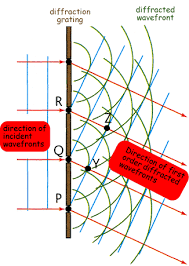Monochromator
A device used to produce light of a single wavelength
is called a monochromator.
There are two types of monochromators given below:
Prism Monochromator
Light from the radiation source is passed through the collimator. Collimeter is a device used to get a
single beam. It makes narrow waves or beams align in a specific direction.
A triangle has a refracting surface that separates white light into a spectrum of seven colors. It is made up of glass.
The beam of light is passed through the prism. The
prism resolves the beam of light into different wavelengths. The longer the
wavelengths, the more the bend of wavelength will occur.
A wavelength selector or filter selects a specific wavelength, which is then passed through the exit slit. An exit slit is
used to get a narrow beam of light.
Transmission grating Monochromators
A diffraction grating is made up of transparent
glass. It consists of a series of parallel grooves on a reflecting surface as
shown in the figure below.
Each groove
is working as a small separate mirror from which reflected light interacts and
interference occurs.
The most commonly used numbers of grooves are 300-2000 per millimeter. The numbers of grooves are 1200-14000 per millimeter are also available.
Both types of interference can occur, constructive
and destructive interference. We can calculate it by the following formula:
d (sin i +sin r)
Where m is the positive integer, d is the path difference; ƛ is
the wavelength of light, Sin i
For constructive interference, path length can be calculated as
dsinθ=m ƛ
For destructive interference, path length can be calculated as dsinθ=
(n+0.5) ƛ
This phenomenon is used for UV-visible or near Infrared
spectroscopy.
Advantages of Transmission Grating over Prism Monochromator
|
Transmission grating monochromator |
Prism monochromator |
|
Better
resolution and energy. |
Temperature
affects the wavelength |
|
Linear dispersion of light |
Non-linear
dispersion occurs less |
|
Less
complicated |
Temperature
affects the prism |
|
A
drive mechanism |
|








0 Comments